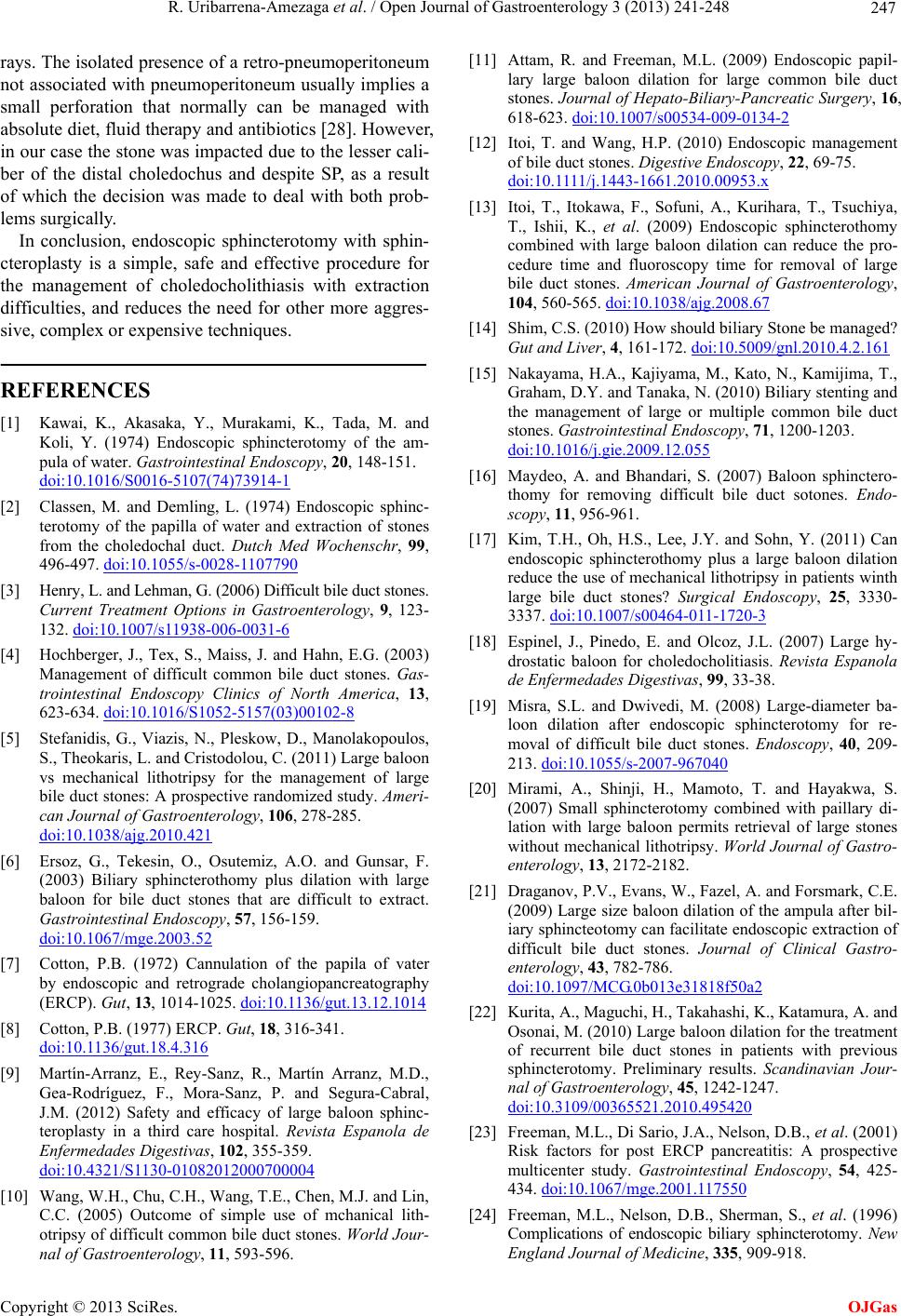
R. Uribarrena-Amezaga et al. / Open Journal of Gastroenterology 3 (2013) 241-248 247
rays. The isolated presence of a retro-pneumoperitoneum
not associated with pneumoperitoneum usually implies a
small perforation that normally can be managed with
absolute diet, fluid therap y and antibiotics [28]. However,
in our case the stone was impacted due to the lesser cali-
ber of the distal choledochus and despite SP, as a result
of which the decision was made to deal with both prob-
lems surgically.
In conclusion, endoscopic sphincterotomy with sphin-
cteroplasty is a simple, safe and effective procedure for
the management of choledocholithiasis with extraction
difficulties, and reduces the need for other more aggres-
sive, complex or expensive techniques.
REFERENCES
[1] Kawai, K., Akasaka, Y., Murakami, K., Tada, M. and
Koli, Y. (1974) Endoscopic sphincterotomy of the am-
pula of water. Gastrointestinal Endoscopy, 20, 148-151.
doi:10.1016/S0016-5107(74)73914-1
[2] Classen, M. and Demling, L. (1974) Endoscopic sphinc-
terotomy of the papilla of water and extraction of stones
from the choledochal duct. Dutch Med Wochenschr, 99,
496-497. doi:10.1055/s-0028-1107790
[3] Henry, L. and Lehman, G. (2006) Difficult bile duct stones.
Current Treatment Options in Gastroenterology, 9, 123-
132. doi:10.1007/s11938-006-0031-6
[4] Hochberger, J., Tex, S., Maiss, J. and Hahn, E.G. (2003)
Management of difficult common bile duct stones. Gas-
trointestinal Endoscopy Clinics of North America, 13,
623-634. doi:10.1016/S1052-5157(03)00102-8
[5] Stefanidis, G., Viazis, N., Pleskow, D., Manolakopoulos,
S., Theokaris, L. and Cristodolou, C. (2011) Large baloon
vs mechanical lithotripsy for the management of large
bile duct stones: A prospective randomized study. Ameri-
can Journal of Gastroenterology, 106, 278-285.
doi:10.1038/ajg.2010.421
[6] Ersoz, G., Tekesin, O., Osutemiz, A.O. and Gunsar, F.
(2003) Biliary sphincterothomy plus dilation with large
baloon for bile duct stones that are difficult to extract.
Gastrointestinal Endoscopy, 57, 156-159.
doi:10.1067/mge.2003.52
[7] Cotton, P.B. (1972) Cannulation of the papila of vater
by endoscopic and retrograde cholangiopancreatography
(ERCP). Gut, 13, 1014-1025. doi:10.1136/gut.13.12.1014
[8] Cotton, P.B. (1977) ERCP. Gut, 18, 316-341.
doi:10.1136/gut.18.4.316
[9] Martín-Arranz, E., Rey-Sanz, R., Martín Arranz, M.D.,
Gea-Rodríguez, F., Mora-Sanz, P. and Segura-Cabral,
J.M. (2012) Safety and efficacy of large baloon sphinc-
teroplasty in a third care hospital. Revista Espanola de
Enfermedades Digestivas, 102, 355-359.
doi:10.4321/S1130-01082012000700004
[10] Wang, W.H., Chu, C.H., Wang, T.E., Chen, M.J. and Lin,
C.C. (2005) Outcome of simple use of mchanical lith-
otripsy of difficult common bile duct stones. World Jour-
nal of Gastroenterology, 11, 593-596.
[11] Attam, R. and Freeman, M.L. (2009) Endoscopic papil-
lary large baloon dilation for large common bile duct
stones. Journal of Hepato-Biliary-Pancreatic Surgery, 16,
618-623. doi:10.1007/s00534-009-0134-2
[12] Itoi, T. and Wang, H.P. (2010) Endoscopic management
of bile duct stones. Digest ive Endoscopy, 22, 69-75.
doi:10.1111/j.1443-1661.2010.00953.x
[13] Itoi, T., Itokawa, F., Sofuni, A., Kurihara, T., Tsuchiya,
T., Ishii, K., et al. (2009) Endoscopic sphincterothomy
combined with large baloon dilation can reduce the pro-
cedure time and fluoroscopy time for removal of large
bile duct stones. American Journal of Gastroenterology,
104, 560-565. doi:10.1038/ajg.2008.67
[14] Shim, C.S. (2010) How should biliary Stone be managed?
Gut and Liver, 4, 161-172. doi:10.5009/gnl.2010.4.2.161
[15] Nakayama, H.A., Kajiyama, M., Kato, N., Kamijima, T.,
Graham, D.Y. and Tanaka, N. (2010) Biliary stenting and
the management of large or multiple common bile duct
stones. Gastrointestinal Endoscopy, 71, 1200-1203.
doi:10.1016/j.gie.2009.12.055
[16] Maydeo, A. and Bhandari, S. (2007) Baloon sphinctero-
thomy for removing difficult bile duct sotones. Endo-
scopy, 11, 956-961.
[17] Kim, T.H., Oh, H.S., Lee, J.Y. and Sohn, Y. (2011) Can
endoscopic sphincterothomy plus a large baloon dilation
reduce the use of mechanical lithotripsy in patients winth
large bile duct stones? Surgical Endoscopy, 25, 3330-
3337. doi:10.1007/s00464-011-1720-3
[18] Espinel, J., Pinedo, E. and Olcoz, J.L. (2007) Large hy-
drostatic baloon for choledocholitiasis. Revista Espanola
de Enfermedades Digestivas, 99, 33-38.
[19] Misra, S.L. and Dwivedi, M. (2008) Large-diameter ba-
loon dilation after endoscopic sphincterotomy for re-
moval of difficult bile duct stones. Endoscopy, 40, 209-
213. doi:10.1055/s-2007-967040
[20] Mirami, A., Shinji, H., Mamoto, T. and Hayakwa, S.
(2007) Small sphincterotomy combined with paillary di-
lation with large baloon permits retrieval of large stones
without mechanical lithotripsy. World Journal of Gastro-
enterology, 13, 2172-2182.
[21] Draganov, P.V., Evans, W., Fazel, A. and Forsmark, C.E.
(2009) Large size baloon dilation of the ampula after bil-
iary sphincteotomy can facilitate endoscopic extraction of
difficult bile duct stones. Journal of Clinical Gastro-
enterology, 43, 782-786.
doi:10.1097/MCG.0b013e31818f50a2
[22] Kurita, A., Maguchi, H., Takahashi, K., Katamura, A. and
Osonai, M. (2010) Large baloon dilation for the treatment
of recurrent bile duct stones in patients with previous
sphincterotomy. Preliminary results. Scandinavian Jour-
nal of Gastroenterology, 45, 1242-1247.
doi:10.3109/00365521.2010.495420
[23] Freeman, M.L., Di Sa rio, J.A., Nelson, D. B., et al. (2001)
Risk factors for post ERCP pancreatitis: A prospective
multicenter study. Gastrointestinal Endoscopy, 54, 425-
434. doi:10.1067/mge.2001.117550
[24] Freeman, M.L., Nelson, D.B., Sherman, S., et al. (1996)
Complications of endoscopic biliary sphincterotomy. New
England Journal of Medicine, 335, 909-918.
Copyright © 2013 SciRes. OJGas